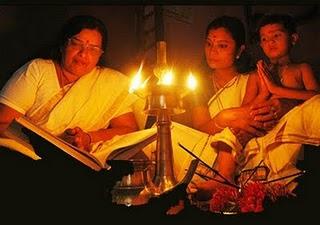Ramayana Masam 2011 Begins on 17th July
In 2011 Ramayana masam is celebrated from July 17th to Aug 16th. In most of the temples Ramayana masam is celebrated with great importance. The rituals will go on till the end of Ramayana masam. Read here about the idea behind Ramayana masam and pithru tharpanam. Also read the one slokam consolidation of Ramayanam
Ramayanam, an epic about Lord Sreeraman, the seventh incarnation of Lord Mahavishnu. Ramayanam is written by the great poet Thunchathu Ramanujan Ezhuchathan, who is referred as the father of Malayalam language, somewhere during the 16th century. The easiness of reading this epic in Malayalam, made it popular among keralites. Every Hindu home will have a copy of it and this book is kept as sacred as an idol in a temple. In fact this holly book is worshiped. Mostly this epic is read during the Karkkidaka masam of Malayalam era (mid July to mid Aug every year). The idea behind Ramayana Masam

Ramayana Masam starts from the first of Karkkidakam (in malayalam era) and will end by the 31st day. In olden days, agriculture was the main source of income of most people in Kerala. During the month of June and July, there used to be heavy rain in Kerala. The fields used to be flooded, and the lay men left without job. Thus Karkkidakam got another name as "Panjamasam" (poverty-stricken month), followed by Chingam (the first month of Malayalam era), being the harvest month. To have a good harvest during chingamasam, our fore fathers believed that worshipping Lord Rama during karkkidakam will give a good yield. Thus the epic Ramayana was read in their homes. The entire book is read in 31 days, starting the first day of Karkkidakam. Another belief about Karkkidakam
is that, this month is dedicated to the dead fore fathers and pithru tharpanam (a ritual, believed as feeding the souls) is offered to their souls. This offering is used to take place in all temples on the day of karkkidaka vavu .
Great valmiki composed this epic in Sanskrit language. It had seven sections. They are Bala Kaandam, Ayodhya Kaandam, Aranya Kaandam, Kishkinda Kaandam, Sundara Kaandam, Yudha kaandam and the Uttarakaandam. The entire ramayanam can be consolidated in one slokam as below
Adau Rama tapo vanaadi gamanam hatva mrugam kaanchanam
Vaidehee haranam jadaayu maranam sugreeva sambhashanam
Balee nigrahanam samudra tharanam lankapury dahanam
Paschaat raavana kumbhakarna hananam etatdhi ramayanam.

 Job oriented
Job oriented